A7 Fighter Jet is a futuristic concept jet based on WWII aesthetics with advanced technology that we have now. As you can see, the result is awesome sci-fi jet that features historical as well as timeless design. Designed by Juan Garcia Mansilla, he also created a background story for this project.
July 1942, Hydra rules the skies above Nazi Germany after successful covert operation led by Captain America (a.k.a Cap. Steve Rogers). He managed to get into Hydra’s Research Facility where a sample of Tesseact was retrieved and taken to the U.S for weapons development. Howard Stark, together with his team, has produced a series of fighter jet prototypes after months of development, each one is equipped with above technology. After 7 prototypes, a small production has been approved, this’s when Amelia 7 Fighter Jet was born.
Designer : Juan Garcia Mansilla
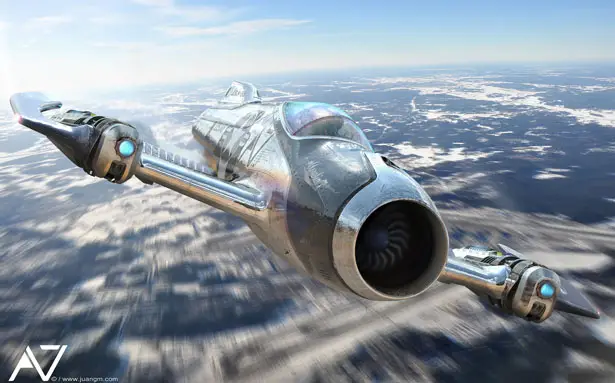
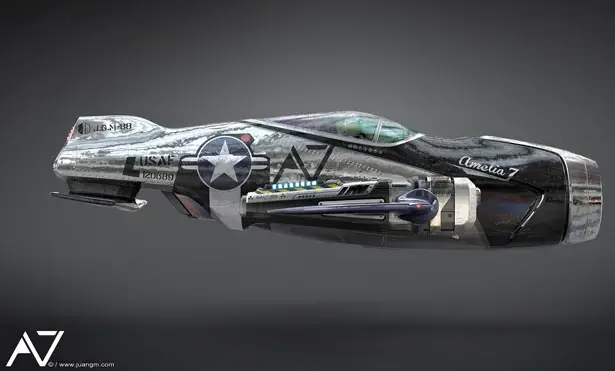
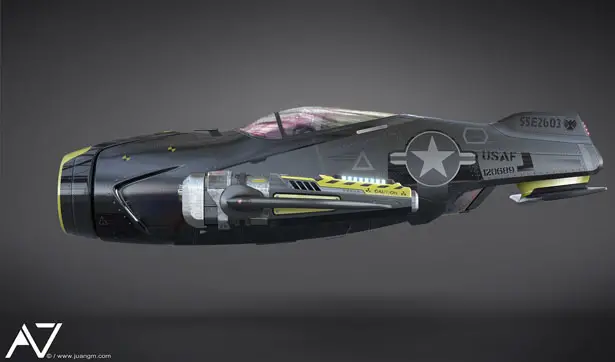
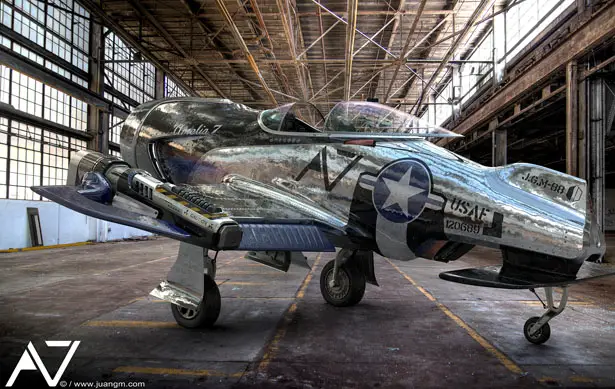
More images of A7 Fighter Jet:
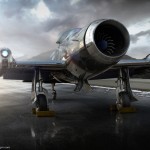
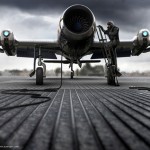
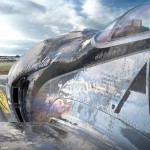
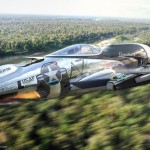
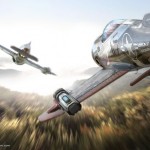
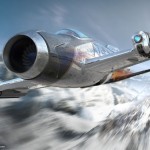
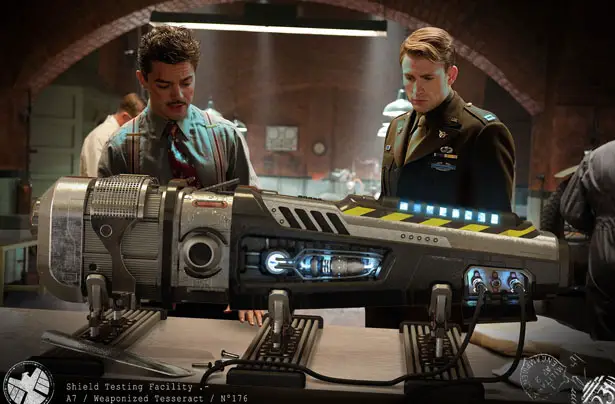








Let me guess? Captain America and DEVIANTArt…
"A", as in A7, is a Navy, and Air Force, designation for "Attack" aircraft, as in air-to-ground. The designator "A7" has already been used in the Viet Nam-era A7, built by LTV. The services do not reuse designations so A7 is already taken. The current "A"-plane is the A10 Warthog built by Fairchild Republic so any new attack aircraft would be at least the A11.
The timeline for this is WWII so it would pre-date that A7 right?
May I as an amateur aircraft designer (meaning, I only fly virtual X-Plane aircraft and a handful of foamie R/C planes) and aerodynamics student (I study historical designs for self entertainment and learning) apply my meager knowledge to this design.
Short stubby wings would require fast takeoff and landing speeds. But would give good top speed. The airfoil is a flat-plane type but with a blunt leading edge, it would have poor high speed stability when maneuvering and a sharp stall.
I think the pod things on the wings are guns?
They should be mounted in aerodynamic fairings to reduce drag and as close to the centerline as possible for best accuracy. If they need to be cooled, the fairing will have small vents to allow cooling air through. Air needs to move slower to absorb heat anyway.
The wingtip “thingies” look like they are used for control. They are poorly shaped aerodynamically, and would add allot of drag.
The low set canopy looks at home for air racing but not for visibility. However, early WWII aircraft had pretty poor visibility so we will let that one slide.
Horizontal stabilizer is small but should work, if only because it’s a full moving stabilator. It would be more effective if mounted above the main wing’s line of flight, as the turbulence from the main wing, especially since small wings have higher wing loading. However, the jet thrust is blowing at the stabilator, which is bad. If the idea is to create a form of thrust vectoring, this is a bad way to do it. Plus, the leading edge is rounded, causing massive drag when being blasted by the jet thrust. In normal use, that rounded edge is good for smooth airflow. But in a situation where you are directing thrust, the leading edge should cut into the thrust a bit more. But since the stabilator is moving, the leading edge needs to accommodate different angles of attack from the thrust, so a sharp leading edge is…..never mind, its a bad design, don’t do that. Don’t put moving surfaces in the flow of the jet thrust unless it’s deliberately thrust vecoring, which is done from the outside edges. This would be better with a directable thrust nozzle instead of moving control surfaces. But that would still need some fins for stability to keep the craft pointed in the direction you want it to go.
There’s no good method of yaw that I can see. Unless the ailerons can split. Yaw stability will be poor causing a danger of flat spins.
There isn’t enough room for the pilots body, seat, instruments, etc; with the engine the size it is. There are ways around this, such as having the fan that is visible be a bypass fan for the engine. So we can overlook that.
The artists skill as an artist is fantastic! The images and rendering is beautiful! But I understood basic aerodynamic principles by the time I was 15 that would have prevented me from designing this useless manned missile.
Also, it’s supposed to look 1940s, but it looks more like 1990s racing planes.
As cool as this looks, and it does look cool. (I saved one of the pictures as my desktop background)
It is an unarguable deathtrap.
The art quality however is amazing and beautiful. The artist is really good at making it look realistic and even period styled. The artist deserves to be respected and appreciated for making things like this. Nothing I say is in any way meant to detract from the skill of the artist as an artist.
However, while I am by no means a professional in aerodynamics, I am a well studied aviation history buff, an avid pilot and an amateur aerodynamicist. Granted, most of my designs only ever fly inside of X-Plane or if they are lucky, they get turned into wood & foam R/C models. So what I am doing here is simply to explore the idea that if this were a real world aircraft, what would be the pros and cons of the design. Again, I am not intending to be in any way disparaging of the artist or their art. I only wish to enjoy the pastime of critiquing the DESIGN of the craft. Artists come up with awesome ideas and sometimes they even work in the real world. 🙂
The wings being short is not a problem for a jet, look at the F-104 Starfighter. So that is no issue.
However, the airfoil shape is all wrong for a craft like this. The leading edge is too thick and the foil is what they call 'flat-plate' meaning its just a flat wing with little or no airfoil shape. Once craft get above a certain speed, airfoils are unnecessary and flat plates work great. However, the wing needs a thin leading edge to allow the air to flow unbroken over the wing. The thick, blunt leading edge here would cause lots of issues with air de-laminating from the wing.
There is no vertical fins to speak of. This isn't needed as many aircraft don't have them. However, the stubby fin thingy on the top of the tail is cut off bluntly, this creates a suction zone. Some cars do this on purpose, allowing a small bubble of low pressure that at low speeds is aerodynamically clean. But airplanes should never do this. It creates huge drag at high speeds.
If there is no vertical fins, there needs to be another method of yaw control and stabilization. The wings are too short and unswept to use wing washout or tip twist for stability. So even if the yaw is controlled by split ailerons, the plane would be very unstable.
The horizontal stabilizer & elevator looks to be a stabilator (one piece, fully moving rather than having a hinged part in the back) but it is fully blended into the short stub that is hangs from with no means of movement. To make this worse, it is mounted at a few degrees angle from the direction of flight, so the plane would always want to climb. Worse still, it is right in the path of the jet thrust…which if you are trying to make a form of thrust vectoring, this is a very bad way to do it. The thrust hits the airfoil and creates extra drag and thrust deflection to the sides. Also the heat will be a major issue, damaging the tail surfaces over short amount of time.
The guns are not in aerodynamic fairings and they should be mounted close to the fuselage to get them as close to the centerline as possible. Fighters like the P-38 and Beaufighter were loved because the guns were on the centerline and did not need to converge at some distance in front of the craft. If the guns need cooling, the fairings will have the needed vents. Air needs to move slower to cool better, (takes time for air to absorb heat).
The wingtips are shaped into weird hook things. What are those and what are they for? Do they serve a purpose other than creating extra drag?
So this is a beautiful, undoubtedly very fast vehicle which which to kill oneself at the end of the runway.